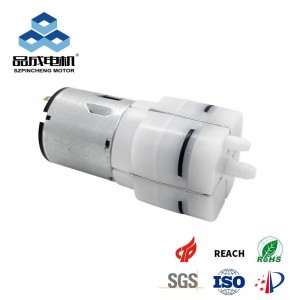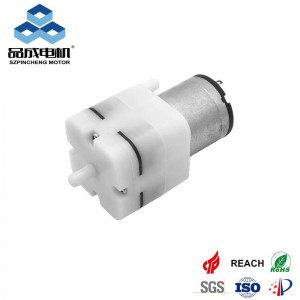Selecting the perfect vacuum pump is critical for the success of any project, from scientific experiments and medical devices to DIY automation and robotics. If you're working with portable, low-power, or automotive applications, a 12V micro vacuum pump is often the ideal choice. But how do you determine what size you need? This guide will walk you through the key factors to consider.
Understanding the Key Specifications: Flow Rate and Vacuum Level
The "size" of a vacuum pump isn't just its physical dimensions; it's primarily about its performance characteristics. Two specs are king:
-
Flow Rate (CFM or LPM): This measures the pump's speed—how much air it can move at atmospheric pressure. It's often denoted as Free Air Flow (CFM - Cubic Feet per Minute or LPM - Liters Per Minute). A higher flow rate means the pump can evacuate a large volume of air quickly, which is crucial for reaching your desired vacuum level fast.
-
Think of it like: The diameter of a hose. A wider hose (higher flow rate) fills or empties a pool much faster than a narrow one.
-
-
Maximum Vacuum Level (inHg or kPa): This measures the pump's ultimate strength—the deepest vacuum it can achieve, measured in inches of Mercury (inHg), pascals (Pa), or kilopascals (kPa). Common 12V micro vacuum pumps might range from 5 inHg (for simple suction) to over 22 inHg (for a strong vacuum).
-
Think of it like: The water pressure in that hose. Higher pressure can push water further uphill.
-
Your application will dictate which of these two metrics is more important. Often, you need a balance of both.
A Step-by-Step Guide to Sizing Your 12V Micro Pump
Follow these steps to narrow down your choices:
1. Define Your Application's Core Requirement:
-
Is it for Suction (Pick and Place, Holding)? For example, using a vacuum cup to lift and move objects. This typically requires a higher flow rate to quickly create a vacuum in the cup, ensuring a strong and immediate grip. The ultimate vacuum level is still important to hold the weight.
-
Is it for Evacuation (Removing Air from a Container)? For example, degassing resins or creating a low-pressure environment in a small chamber. This often requires a higher maximum vacuum level to remove as much air as possible, even if it takes a bit longer.
2. Calculate the Volume You Need to Evacuate:
This is crucial for flow rate. You need a pump that can handle the internal volume of your system.
-
Simple Rule: A larger chamber or longer, wider tubing requires a pump with a higher flow rate (LPM or CFM) to achieve a vacuum in a reasonable time.
-
Quick Calculation: If you have a 1-liter chamber and want to evacuate it in 10 seconds, you would need a pump with a flow rate of at least 6 LPM (1 liter / 10 seconds * 60 seconds). Always choose a pump with a flow rate higher than your calculation to account for inefficiencies.
3. Determine the Required Vacuum Level:
How strong does the vacuum need to be?
-
Light Holding: 3-5 inHg might be sufficient.
-
General Purpose/Medium Duty: 7-15 inHg is a common range for many 12V micro vacuum pump applications.
-
Strong Vacuum (e.g., for degassing): 18-22 inHg or higher. Note that achieving these levels with a small 12V pump often requires a diaphragm pump design and more power.
4. Consider Your Power Source:
Since you're looking at a 12V DC micro vacuum pump, this is a key advantage. They are designed for:
-
Portable battery-operated projects
-
Automotive and marine applications
-
Solar-powered systems
-
Anywhere a standard wall outlet is not available
Check the pump's current draw (in Amps). A higher-power pump will create a stronger vacuum but will also drain a battery faster. Ensure your battery or 12V power supply can deliver the required current.
5. Don't Forget the Details:
-
Port Size: Ensure the pump's inlet/outlet ports fit your tubing.
-
Duty Cycle: Can the pump run continuously, or does it need to cycle on and off (e.g., 1 minute on, 1 minute off)? This prevents overheating.
-
Noise Level: Diaphragm pumps are generally quieter than piston pumps, which is important for consumer devices or lab equipment.
-
Oil-Free vs. Lubricated: Micro vacuum pumps are almost always oil-free (dry), meaning they are maintenance-free and won't contaminate your application—perfect for clean environments like food handling or medical devices.
Common Applications for 12V Micro Vacuum Pumps
-
DIY Automation: PCB handling, 3D printer part cooling, vacuum tables.
-
Medical & Lab Equipment: Portable aspirators, fluid handling, gas sampling.
-
Food & Packaging: Small vacuum sealers for bags or containers.
-
Hobbies & Robotics: Suction cups for robot arms, model-making.
-
Environmental Monitoring: Air sampling devices.
Conclusion
Choosing the right 12V micro vacuum pump boils down to understanding the trade-off between flow rate (speed) and maximum vacuum (strength). Define your project's primary goal, calculate the volume of your system, and determine the necessary vacuum level. By carefully matching these requirements to the pump's specifications, you'll select a pump that is powerful, efficient, and perfectly sized for your needs, ensuring your 12V-powered project is a success.
you like also all
Read More News
Post time: Sep-18-2025




